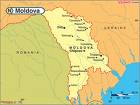Before I left Canada, I took my son and daughter and their respective significant others to a Moldovan restaurant in Toronto. I was told that a typical Moldovan dish is ‘mamaliga’ and so I ordered that, just to try it. The first truth about mamaliga that I learned there, is that it comes in a mound. Secondly, it is served with sour cream. And there was something else at that restaurant, but I don’t remember it. In any case, the second time I had mamaliga was at the girls’ house here at the OM Centre. The girls take turns preparing the meals and all seemed pleased on this particular evening at the prospect of having mamaliga. True to form, it was served in a huge mound on a plate in the centre of the table and people helped themselves in large spoonfuls. There was sour cream to go with it and some kind of meat sauce also. The Moldovans present really enjoyed the mamaliga, with or without the meat sauce. Personally, I felt that the meat sauce provided some of the needed flavour.
Today I found out exactly what mamaliga is, although I was pretty sure I knew. This morning in my new casa my hosts were preparing a scrumptious breakfast of mamaliga. I watched Lena make it – basically adding cornmeal to boiling water – and there you have it: mamaliga! True to form, it was served in a big mound on each plate and I was madly scrambling for the words I had learned the other day but have quickly forgotten for ‘Stop! That’s enough!!’ We stood to pray before sitting down to this new breakfast adventure.
The secret, I think, of good mamaliga is not the substance itself but what it is served with. First of all there is a dish with crushed garlic cloves – many of them – mixed with oil, water, and a strange substance she referred to as borsch which could be broth, I suppose, but I really don’t know. Domnul Gisca (Mr. Gisca, or Ion is his name) had crushed an odd-looking cheese that apparently is made from sheep’s milk. So, you take a forkful of mamaliga, dip it in the oil/garlic mixture, then in the crumbled cheese, then in the sour cream. The garlic really gives it the flavour it needs and the sour cream eases the nip of all that garlic! We were happily eating our mamaliga and I do like it ok, then Ion pulls a bottle out from under the table and pours the contents into a bowl. They set that between them and give me a small bowl for myself. It looks kind of like sour cream but lumpier and more runny and I mistakenly put some on my plate to go with my mamaliga. Wrong! I watch as they drink it by the spoonful from their bowl and Lena encourages me to do the same. I taste it and it’s really not too bad. I ask what it is and basically Ion says they buy it (milk??) from the store, leave it in a bottle for 3 days and then drink/eat it. So does that mean it is sour milk? Not sure – not sure I want to know - but it was good.
Unfortunately I need to leave in time to be at the centre at 9 and there is no way I can finish the mound of mamaliga that is still on my plate. I am realizing that breakfast really is the main meal of the day and although I am rarely hungry enough to eat everything they want to feed me at breakfast, I might do well to do so as the evening meal is basically bread and tea. I apologise profusely, thank them for the wonderful breakfast, and rush off to catch my minibus to the OM Centre.
Mamaliga – a true Moldovan meal! Slava Dumneul! (Praise God!)
Subscribe to:
Post Comments (Atom)



Hi Barb,
ReplyDeleteThe food certainly sounds interesting! And your adventures are non stop. All of your stories are so much fun to read and I always look forward to your next blog. This is a wonderful way for you to keep in touch with everybody and I thoroughly enjoy reading them. Who knows, maybe you will write a book when you return home. All the best to you.
Well, first of all its "Slava Domnului" (not "Domneul"). Regarding mamaliga -- it IS a traditional dish that you would NEVER be served when invited to a middle class family in Chisinau(well, "middle class" in Moldova is hard to define, but I'll take a shot: university professors, doctors, managers, employees of intl. organizations, IT and other professionals). Probably the only decent restaurant in Chisinau serving placinta is "La Taifas" (but their prices are astronomical, given that they target foreign tourists), and my guess is that it’s NOT the most popular dish there (at least not among the Moldovans who accompany the foreign guests).
ReplyDelete“Tocana cu mamaliga” (the traditional dish with mamaliga, “tocana” is very greasy pork meat in garlic sauce) is the ultimate cholesterol bomb. It probably was a good solution for those who needed lots of energy to work in the field. Nowadays, such caloric food looses any meaning (at least in the city).
My guess is that "placinta" (esp. with cottage cheese -- really miss it...) is a much more widespread national dish.